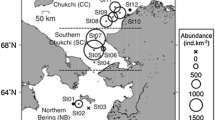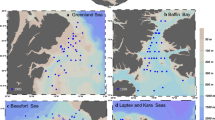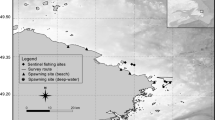Abstract
Reduction in sea ice due to climate change is expected to have a negative impact on habitat availability for Arctic marine fishes and induce range expansion of species from southern environments. Such an effect will likely be observed in the abundance of polar cod, Boreogadus saida (Lepechin, 1774), as well as interspecific interactions of this intermediate-level trophic taxon, particularly in more southerly fringing seas in the Arctic. Polar cod and capelin, Mallotus villosus (Müller, 1776), are pelagic, planktivorous forage fishes, which occupy similar dietary niches and are the primary prey of marine predators. Co-occurring polar cod and capelin were collected at seven stations in Darnley Bay, NT, during August 2013. Standard length (SL), used as a proxy for age, suggested that polar cod (mean ± 1 SD: 71.1 ± 10.3 mm) were predominantly age 1+ and capelin (96.2 ± 13.4 mm) were mostly age 2+. Stomach content analyses indicated that both species feed extensively on calanoid copepods (Calanus hyperboreus, C. glacialis, Metridia longa) and amphipods (Themisto libellula). There was high dietary overlap between capelin and polar cod, evidenced by Schoener’s index (0.80). Additionally the quantity of dietary items, biomass and energetic content consumed differed among size classes in both capelin (SL, 70.5–132.0 mm) and polar cod (SL, 42.1–114.4 mm). This study illustrates that the diets of these sympatric forage fishes in an Arctic ecosystem are very similar, indicating a high potential for interspecific competition as the sub-Arctic capelin expands its range into Arctic regions with climate change.





Similar content being viewed by others
References
Ajiad AM, Gjøsæter H (1990) Diet of polar cod, Boreogadus saida, in the Barents Sea related to fish size and geographical distribution. ICES CM G:48
Barluenga M, Stölting KN, Salzburger W et al (2006) Sympatric speciation in Nicaraguan crater lake cichlid fish. Nature 439:719–723. doi:10.1038/nature04325
Beaugrand G (2003) Long-term changes in copepod abundance and diversity in the north-east Atlantic in relation to fluctuations in the hydroclimatic environment. Fish Oceanogr 12:270–283
Benoit D, Simard Y, Fortier L (2008) Hydroacoustic detection of large winter aggregations of Arctic cod (Boreogadus saida) at depth in ice-covered Franklin Bay (Beaufort Sea). J Geophys Res 113:C06S90. doi:10.1029/2007JC004276
Bradstreet MSW, Finley KJ, Sekerak AD, Griffiths WD, Evans CR, Fabijan MF, Stallard HE (1986) Aspects of the biology of Arctic cod Boreogadus saida and its importance in Arctic marine food chains. Can Tech Rep Fish Aquat Sci 1491(1):1–193
Carscadden J, Vilhjálmsson H (2002) Capelin—What are they good for? Introduction. ICES J Mar Sci 59:863–869. doi:10.1006/jmsc.2002.1283
Daase M, Falk-Petersen S, Varpe Ø, Darnis G, Søreide JE, Wold A, Leu E, Berge J, Philippe B, Fortier L (2013) Timing of reproductive events in the marine copepod Calanus glacialis: a pan-Arctic perspective. Can J Fish Aquat Sci 70:871–884
Dalpadado P, Mowbray F (2013) Comparative analysis of feeding ecology of capelin from two shelf ecosystems, off Newfoundland and in the Barents Sea. Prog Oceanogr 114:97–105. doi:10.1016/j.pocean.2013.05.007
Dalpadado P, Bogstad B, Eriksen E, Rey L (2009) Distribution and diet of 0-group cod (Gadus morhua) and haddock (Melanogrammus aeglefinus) in the Barents Sea in relation to food availability and temperature. Polar Biol 32:1583–1596. doi:10.1007/s00300-009-0657-7
Davies RW, Wrona FJ, Linton L, Wilkialis J (1981) Inter- and intra-specific analyses of the food niches of two sympatric species of Erpobdellidae (Hirudinoidea) in Alberta, Canada. Oikos 37:105–111
Drinkwater KF, Beaugrand G, Kaeriyama M et al (2009) On the processes linking climate to ecosystem changes. J Marine Syst 79:374–388. doi:10.1016/j.jmarsys.2008.12.014
Falk-Petersen S, Pavlov V, Timofeev S, Sargent JR (2007) Climate variability and possible effects on arctic food chains: the role of Calanus. In: Ørbæk JB, Kallenborn R, Tombre I, Hegseth EN, Falk-Petersen S, Hoel AH (eds) Arctic Alpine ecosystems and people in a changing environment, Springer, Berlin, pp 147–166
Forest A, Galindo V, Darnis G, Pineault S, Lalande C, Tremblay JE, Fortier L (2008) The annual cycle of particulate organic carbon export in Franklin Bay (Canadian Arctic): environmental control and food web implications. J Geophys Res-Oceans 113:C3. doi:10.1029/2007JC004262
Geoffroy M, Majewski A, LeBlanc M, Gauthier S, Walkusz W, Reist JD, Fortier L (2015) Acoustic target strength, vertical distribution and ontogenic migrations of polar cod (Boreogadus saida) in the Canadian Beaufort Sea: an annual cycle. Polar Biol. doi:10.1007/s00300-015-1811-z
Gildberg A (1978) Proteolytic activity and the frequency of burst bellies in capelin. Int J Food Sci Tech 13:409–416. doi:10.1111/j.1365-2621.1978.tb00820.x
Gjøsæter H, Loeng H (1987) Growth of the Barents Sea capelin, Mallotus villosus, in relation to climate. Environ Biol Fish 20:293–300
Graham C, Oxtoby L, Wang SW et al (2014) Sourcing fatty acids to juvenile polar cod (Boreogadus saida) in the Beaufort Sea using compound-specific stable carbon isotope analyses. Polar Biol. doi:10.1007/s00300-014-1470-5
Hop H, Gjøsæter H (2013) Polar cod (Boreogadus saida) and capelin (Mallotus villosus) as key species in marine food webs of the Arctic and the Barents Sea. Mar Biol Res 9:878–894. doi:10.1080/17451000.2013.775458
Hop H, Tonn WM (1998) Gastric evacuation rates and daily rations of Arctic cod (Boreogadus saida) at low temperatures. Polar Biol 19:293–301. doi:10.1007/s003000050249
Hop H, Tonn WM, Welch HE (1997) Bioenergetics of Polar cod (Boreogadus saida) at low temperatures. Can J Fish Aquat Sci 54:1772–1784. doi:10.1139/f97-086
Hop H, Borga K, Wing G et al (2002) Food web magnification of persistent organic pollutants in poikilotherms and homeotherms from the Barents Sea. Environ Sci Technol 36:2589–2597. doi:10.1021/es010231l
Laidre KL, Stirling I, Lowry LF et al (2008) Quantifying the sensitivity of Arctic marine mammals to climate-induced habitat change. Ecol Appl 18:S97–125
Loseto LL, Stern GA, Connelly TL et al (2009) Summer diet of beluga whales inferred by fatty acid analysis of the eastern Beaufort Sea food web. J Exp Mar Bio Ecol 374:12–18. doi:10.1016/j.jembe.2009.03.015
Majewski AR, Walkusz W, Lynn BR, Atchison S, Eert J, Reist JD (in review) Distribution and diet of demersal Arctic Cod, (Boreogadus saida), in relation to habitat characteristics in the Canadian Beaufort Sea. Polar Biol.
Moore SE, Laidre KL (2006) Trends in sea ice cover within habitats used by bowhead whales in the western Arctic. Ecol Appl 16:932–944
Moulton LL, Tarbox KE (1987) Analysis of polar cod movements in the Beaufort Sea nearshore region, 1978–79. Arctic 40:43–49
O’Driscoll RL, Parsons MJD, Rose GA (2001) Feeding of capelin (Mallotus villosus) in Newfoundland waters. Sarsia 86:165–176
Orlova EL, Dolgov AV, Rudneva GB et al (2009) Trophic relations of capelin Mallotus villosus and polar cod Boreogadus saida in the Barents Sea as a factor of impact on the ecosystem. Deep-Sea Res Pt II 56:2054–2067. doi:10.1016/j.dsr2.2008.11.016
Parmesan C (2006) Ecological and evolutionary responses to recent climate change. Annu Rev Ecol Evol S 37:637–669. doi:10.2307/annurev.ecolsys.37.091305.30000024
Pomerleau C, Nelson RJ, Hunt BPV et al (2014) Spatial patterns in zooplankton communities and stable isotope ratios (δ13C and δ15 N) in relation to oceanographic conditions in the sub-Arctic Pacific and western Arctic regions during the summer of 2008. J Plankton Res 36:757–775. doi:10.1093/plankt/fbt129
Pörtner HO (2002) Climate variations and the physiological basis of temperature dependent biogeography: systemic to molecular hierarchy of thermal tolerance in animals. Comp Biochem Phys A 132:739–761. doi:10.1016/S1095-6433(02)00045-4
Prowse TD, Furgal C, Wrona FJ, Reist JD (2009) Implications of climate change for northern Canada: freshwater, marine and terrestrial ecosystems. Ambio 38:282–289
Rand KM, Logerwell EA (2011) The first demersal trawl survey of benthic fish and invertebrates in the Beaufort Sea since the late 1970s. Polar Biol 34:475–488. doi:10.1007/s00300-010-0900-2
Renaud PE, Berge J, Varpe Ø et al (2011) Is the poleward expansion by Atlantic cod and haddock threatening native polar cod, Boreogadus saida? Polar Biol 35:401–412. doi:10.1007/s00300-011-1085-z
Robb AP, Hislop JR (1980) The food of five gadoid species during the pelagic 0-group phase in the northern North Sea. J Fish Biol 16:199–217
Scharf FS, Juanes F, Rountree RA (2000) Predator size—Prey size relationships of marine fish predators: interspecific variation and effects of ontogeny and body size on trophic-niche breadth. Mar Ecol-Prog Ser 208:229–248. doi:10.3354/meps208229
Swalethorp R, Kjellerup S, Malanski E, Munk P, Gissel Nielsen T (2014) Feeding opportunities of larval and juvenile cod (Gadus morhua) in a Greenlandic fjord: temporal and spatial linkages between cod and their preferred prey. Mar Biol. doi:10.1007/s00227-014-2549-9
Walkusz W, Paulic JE, Wong S, Papst MH (2010) Distribution, diversity and biomass of summer zooplankton from the coastal Canadian Beaufort Sea. Polar Biol 33:321–335. doi:10.1007/s00300-009-0708-0
Walkusz W, Majewski A, Reist JD (2013) Distribution and diet of the bottom dwelling Polar cod in the Canadian Beaufort Sea. J Mar Syst 127:65–75. doi:10.1016/j.jmarsys.2012.04.004
Wallace RK (1981) An assessment of diet-overlap indexes. T Am Fish Soc 110:72–76. doi:10.1577/1548-8659(1981)110<72
Welch HE, Bergmann M, Siferd TD et al (1992) Energy flow through the marine ecosystem of the Lancaster Sound Region, Arctic Canada. Arctic 45:343–357
Welch HE, Crawford RE, Hop H (1993) Occurrence of polar cod schools and their vulnerability to predation in the Canadian high arctic. Arctic 46:331–339
Winters GH (1982) Life history and geographical patterns of growth in capelin, Mallotus villosus, of the Labrador and Newfoundland areas. J Northw Atl Fish Sci 3:105–114
Acknowledgments
We thank other members of the BREA Marine Fishes Project, S. MacPhee and S. Atchison for aid in sampling and providing analytical advice. This project is supported by Government of Canada funding (Beaufort Sea Regional Environmental Assessment, Environmental Studies Research Fund, Program on Energy Research and Development), Natural Sciences and Engineering Research Council Discovery Grant (GKD) and a University of Manitoba Faculty of Science Scholarship to DGM.
Author information
Authors and Affiliations
Corresponding author
Ethics declarations
Animal specimens used in this study were processed with the animal care permit under the guidelines of Fisheries and Oceans Canada.
Additional information
This article belongs to the special issue on the "Ecology of Arctic Gadids", coordinated by Franz Mueter, Jasmine Nahrgang, John Nelson, and Jørgen Berge.
Rights and permissions
About this article
Cite this article
McNicholl, D.G., Walkusz, W., Davoren, G.K. et al. Dietary characteristics of co-occurring polar cod (Boreogadus saida) and capelin (Mallotus villosus) in the Canadian Arctic, Darnley Bay. Polar Biol 39, 1099–1108 (2016). https://doi.org/10.1007/s00300-015-1834-5
Received:
Revised:
Accepted:
Published:
Issue Date:
DOI: https://doi.org/10.1007/s00300-015-1834-5




